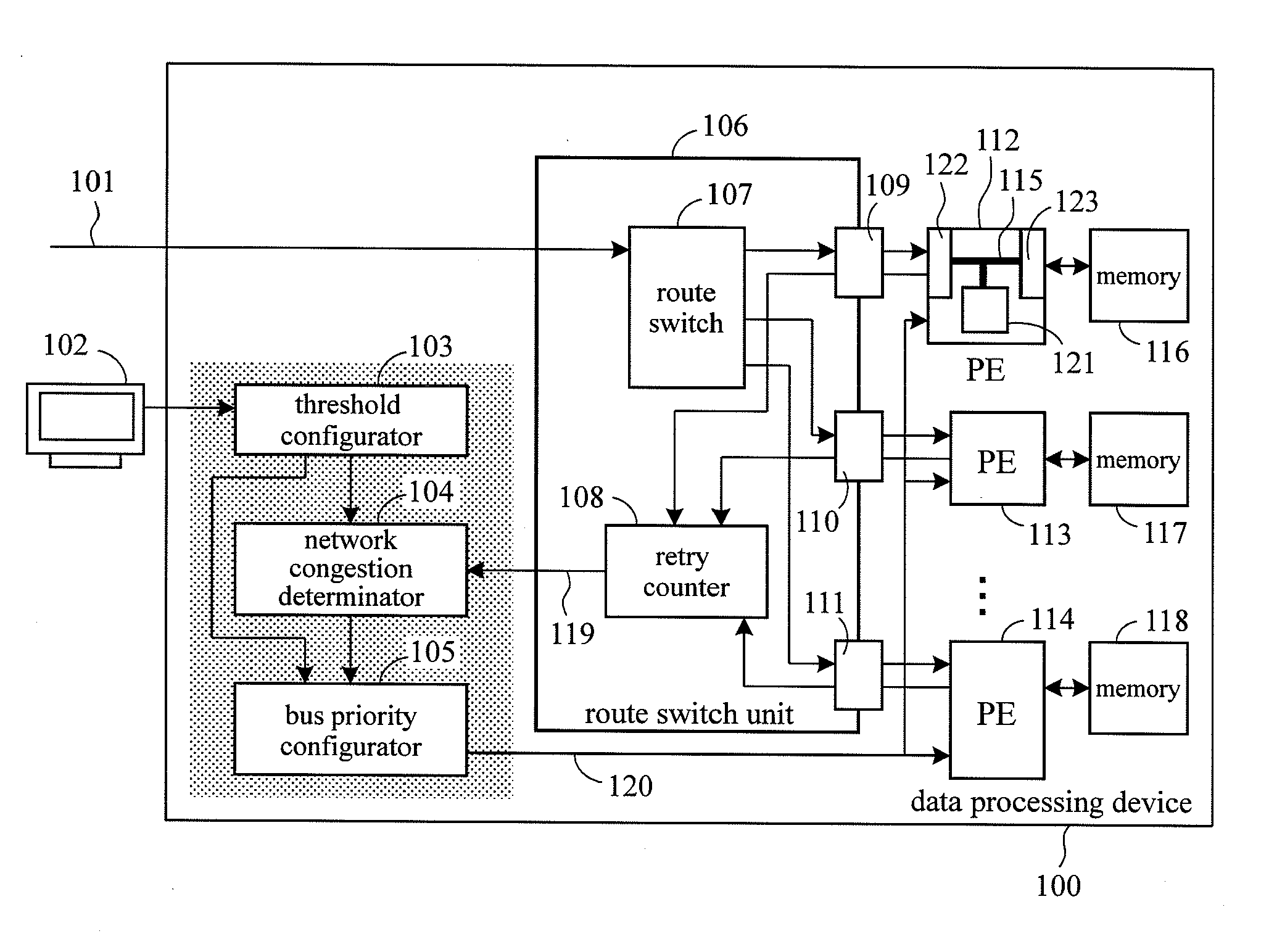Data processing device, semiconductor external view inspection device, and data volume increase alleviation method
a data processing device and semiconductor technology, applied in the direction of instruments, electric digital data processing, processor architecture/configuration, etc., to achieve the effect of suppressing buffer over flows
- Summary
- Abstract
- Description
- Claims
- Application Information
AI Technical Summary
Benefits of technology
Problems solved by technology
Method used
Image
Examples
embodiment 1
Summary
[0103]As discussed thus far, the data processing device 100 according to the embodiment 1 detects the possibility of buffer overflow in advance according to the retry counter value 119 for each of the buffers 109-111, and outputs the bus priority configuration signal 120 to the PEs 112-114. The processor core 121 suspends the data processing and configures the priority control right of the shared bus 115 so that the process data 101 will be preferentially received. This avoids buffer overflow due to the shared bus 115 being occupied.
[0104]In addition, the data processing device 100 according to the embodiment 100 may avoid buffer overflow when temporal network congestion occurs without duplexing the data processing device as in the data processing device 1100 of FIG. 11 or without adding buffers as in the data processing device 1200 of FIG. 12. This may decrease costs of the data processing device, decrease sizes of chassis, and reduce power consumptions.
Embodiment 2
[0105]FIG...
embodiment 2
Summary
[0113]As discussed thus far, the data processing device 1400 according to the embodiment 2 achieves the same advantageous effect as the embodiment 1 only by inputting the effective capacity on the threshold configuration GUI 1402. Thus operational burdens of users may be decreased.
Embodiment 3
[0114]In an embodiment 3 of the present invention, a configuration example will be described where buffer overflow is avoided by load-balancing to other PEs instead of or along with configuring the priority of the shared bus 115 when temporal network congestion occurs.
[0115]FIG. 17 is a configuration diagram of a data processing device 1700 according to the embodiment 3. The data processing device 1700 includes a load balance configurator 1705 instead of the bus priority configurator 105 in the data processing device 100 in the embodiment 1. Further, the data processing device 1700 additionally includes a route switch unit 1706, buffers 1709-1711, PEs 1712-1714, and memories 1716-1718. O...
embodiment 3
Summary
[0125]As discussed thus far, the data processing device 1700 according to the embodiment 3 detects the possibility of occurrence of buffer overflow using the same procedure as that in the embodiments 1-2 to perform load-balancing between the first and second processor cluster, thereby avoiding process stop due to buffer overflow.
[0126]In the embodiment 3, the load balance configurator 1705 may be used with the bus priority configurator 105. In this case, for example, the first processor cluster is used to perform the same procedures as those in the embodiments 1-2 usually. If all of the PEs in the first processor cluster is congested, the packets are load-balanced to the second processor cluster. Alternatively, if the buffer memory in the PEs are full, and further write request toward the memory occurs, the data processing device may determine that the priority configuration in the embodiments 1-2 cannot be performed, and then may perform load-balancing.
Embodiment 4
[0127]FIG....
PUM
 Login to View More
Login to View More Abstract
Description
Claims
Application Information
 Login to View More
Login to View More - R&D
- Intellectual Property
- Life Sciences
- Materials
- Tech Scout
- Unparalleled Data Quality
- Higher Quality Content
- 60% Fewer Hallucinations
Browse by: Latest US Patents, China's latest patents, Technical Efficacy Thesaurus, Application Domain, Technology Topic, Popular Technical Reports.
© 2025 PatSnap. All rights reserved.Legal|Privacy policy|Modern Slavery Act Transparency Statement|Sitemap|About US| Contact US: help@patsnap.com



